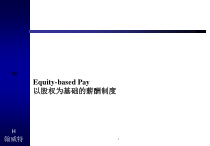 PPT
PPT
【文档说明】以股权为基础的薪酬制度与长期奖励计划.pptx,共(29)页,273.768 KB,由精品优选上传
转载请保留链接:https://www.ichengzhen.cn/view-264961.html
以下为本文档部分文字说明:
1wH翰威特Equity-basedPay以股权为基础的薪酬制度2wH翰威特DateofGrant授予时间DateofExercise工龄0246810121416Gainuponmaturationof
award奖励到期时的利得WhatDoWeMeanby“Equity-Based”Pay?什么是“以股权为基础”的薪酬制度?❖Anyformofpayarrangementalignedwith,orpayingoutin,stock任何以股票形式支付或与股票相关联的薪酬形式❖T
hebasicpayoutopportunityworksasfollows:最基本的支付形式如下图所示:3wH翰威特7B04812/06jpECTSoh.PPT/01-C-02406/2000HewittAssociatesTheBigPicture总体图Perquisites特
殊待遇QualifiedandSupplementalBenefits应有福利和补充福利Long-TermIncentives(Options,etc.)长期奖励计划(期权,等等)AnnualBonus年度奖金BaseSalary基本工资TotalCompensation全面薪酬Th
eEntirePayPicture整体薪酬图4wH翰威特7B04812/06jpECTSoh.PPT/01-C-02406/2000HewittAssociates1990-1999KeyTrendsi
ntheU.S.1TopCorporateOfficers22AverageofCEO,CFO,andLaw1991BaseSalary33%Bonus27%Long-TermIncentives28%Benefits9%Perquisites3%1995BaseSal
ary33%Bonus27%Long-TermIncentives27%Benefits11%Perquisites2%1999BaseSalary28%Long-TermIncentives39%Benefits10%Perquisites2%Bonus21%1
AverageRevenues$2B/MedianRevenues$2BTheEntirePayPicture整体薪酬图5wH翰威特TheEntirePayPicture整体薪酬图7B04812/06jpECTSoh.PPT/01-C-
02406/2000HewittAssociates1990-1999年的美国主趋势1企业高级行政长官22CEO,CFO的平均数1991基本工资33%奖金27%奖金计划28%福利9%特殊待遇3%1995基本工资33%奖金27%长期奖金计划27%福利11%特殊待遇2%1999
基本工资28%长期奖金计划39%福利10%特殊待遇2%奖金21%1平均收入$2B/中位收入$2B6wH翰威特TrendTowardGreaterEquityParticipationforEmployees员工持股已成为全球的趋势❖Increasingnumberofco
mpanieshaveembracedbroad-basedemployeeownership越来越多的公司实施了广泛的员工持股计划—Nonmanagementemployeescollectivel
yownbetween6%and10%oftotalcorporateequity非管理层员工总计持有公司全部股票的6%到10%—Estimated3,000companieshaveinstitutedbroad-base
doptionplanssince1989从1989年开始,大约3,000家公司实施了广泛的员工持股计划—Sharessetasideforoptionsatallpubliccompaniesvaluedat$600Bcomparedwith
$60Bin1985现在所有的上市公司用于股票期权的股票价值已上升到6,000亿美元,而1985年只有600亿美元—41%oflargeU.S.employersgivestockoptionstoatleasthalfoftheirwo
rkforce41%的美国大型企业向一半以上的员工授予股票期权7wH翰威特WhyConsiderEquity-basedPay?为什么考虑以股权为基础薪酬制度?❖Alignmentofshareholdersandemplo
yees’incentiveopportunities统一股东和员工的奖励机会❖Forgestighterbondbetweenexecutivesandotheremployees,asallcanbeputonacommonincen
tiveplatform将管理层和其他员工的薪酬制度紧密结合,使公司所有员工的激励机制趋于统一❖Motivatebroadgroupofemployeestoworktowardcommongoal—inspir
esteamwork鼓励广大员工向共同的目标前进-鼓励团队协作精神❖Incentivepayoutsarea“win-win”situation—paymentsoccurindirectrelationtocomp
anyperformance激励机制处于“双赢”状况-报酬与企业业绩直接挂钩❖Minimizescashoutflow,aspaymentsaremadeinequity由于实施了股权薪酬制度,可以最大限度地减少现金支付8wH翰威特FinancialRea
sonsforProvidingEquity-basedPay提供以股权为基础薪酬形式的财务因素❖StudybyHewittAssociatesandtheJ.L.KelloggGraduateSchoolofM
anagement(NorthwesternUniversity)(1998):翰威特公司和西北大学J.L.Kellogg研究生管理学院联合进行的调查表明(1998年):—Companiesthatinstitutedempl
oyeeownershipprogramsexperiencedanaverageannualReturnOnAssetsof2.6percentagepointsgreaterthanindustryaverageseachyearofthe4-ye
arstudyperiod对实施了员工持股计划的公司进行跟踪调查的四年当中,其资产回报率比同行业平均水平高出2.6个百分点—CumulativeTotalShareholderReturnover4y
earsalso6.9percentagepointsgreaterthancomparisongroupaverages四年中股东回报率要比其他公司高出6.9个百分点—82%ofcompaniesreportedthatownershipprog
ramhadasignificantpositiveimpactonbusinessresults有82%的公司认为,员工持股计划会对经营业绩产生积极影响—Significantcorrelationbetweenc
ompaniesreportingpositiveimpactandeffectivesharinganduseofbusinessinformation分享公司经营信息并加以有效利用与以股权为基础的薪酬计划紧密关联,而这一薪酬计划会对经营业绩产生积极影响9wH翰威特Fi
nancialReasonsforProvidingEquity-basedPay提供以股权为基础薪酬形式的财务因素❖JosephBlasi1996study:JosephBlasi1996年调查指出:
❖Significantlyhighergrowthin10-yearaveragefinancialperformancewhereemployeesownmorethan5%marketvalue当员工所持股
票超过市值的5%时,企业的财政业绩明显高于此前10年的平均增长水平—Nottruewherestockconcentratedamongtop5officers最高级别的五位管理人员持有全部股票的公司未达到这一增长水平❖AmericanCapita
lStrategies:美国的资本战略:—Stockpriceindexofpubliccompanieswithatleast10%employeeownershipoutperformedbroad-basedstockindices员工持股占
10%以上的上市公司的股指比全员持股公司的股指要好—In1992–1995:80.19%versus48.69%fortheDowand44.87%forS&P500在1992-1995年之间,实施员工持股计划的公司和同业公司未实施持股计划的公司相比,道琼
斯指数为80.19%:48.69%,S&P500指数为80.19%:44.87%。10wH翰威特FinancialReasonsforProvidingEquity-basedPay提供以股权为基础薪酬形式的财务因素❖AccordingtoFortuneMagazine’s
100BestCompaniessurvey,ofthosecompaniesthatarepubliclytraded《财富杂志》对世界前100名上市交易公司的调查表明:—60%haveimplementedbroad-basedstockop
tionplans;60%的企业已经实施了广泛的股票期权计划—42%offeroptionstoeveryemployee;and42%为所有员工提供股票期权—80%ofemployeesatthesecompaniesow
ncompanystock这些公司约有80%的员工拥有公司的股票11wH翰威特Long-termIncentivePlanDesign设计长期奖励计划12wH翰威特Overview概况❖Whatarelong-termincentives?
什么是长期奖励?—“Variablecompensationearnedoveraperiodofmorethan12months”12个月以上的可变薪酬❖Historically,theyhavetakenmanyforms:曾在历史上表现出的形式
:—Nonqualifiedstockoptions(“NQSOs”)非资格评定的股票期权(“NQSOs”)—Incentivestockoptions(“ISOs”)(circa1982)激励性的股票期权(“ISOs”)(大约在1982年)—Stockappreciationright
s(“SARs”)(circa1973)股票增值权(“股票增值权”)(大约在1973年)—Performanceplans(circa1975)绩效计划(大约在1975年)13wH翰威特Overview概况❖R
estrictedstock(circa1983)受限股票(大约在1983年)❖Whogetsit?什么人得到这种奖励呢?—Couldbeasbroadasannualincentivesandbeyond(e.g.,stockoptions)orlimitedtojustoffi
cers(e.g.,performanceshares/units)可以象所有员工得到年终奖一样广泛,甚至更多(例如,股票期权)或者只限于主管(例如,绩效股份)❖Almostallmajorindustrialshavesomel
ong-termincentiveplan几乎在所有的主要产业中,都实行了长期奖励计划14wH翰威特10%32%4%44%22%12%55%36%15%45%76%26%79%28%0%10%20%30%40%50%6
0%70%80%90%PhantomStock虚拟股票RestrictedStock受限股票PerformanceShares绩效股票PerformanceUnits绩效单位SARs股票增值权ISOs奖励股票期权NQSOs非资格评定的股票期权1989Prev
alence1999PrevalencePrevalence普遍性/相关值❖Almostallmajorindustrialshavesomelong-termincentiveplan几乎在所有的主要产业中,都实行了长期奖励计划❖Pr
evalence:普遍性:15wH翰威特$0$40$80DateofgrantDateofexerciseDateofsaleOrdinaryIncomeatDateofExercise行权时的一般收入Purchaseprice购买价格Capitalgainatdateofsale
出售时的资本利得DescriptionofStockOptions股票期权❖NQSOs非资格评定的股票期权—Stockoption—righttobuystockatafixedpriceoveraspecifiedperiodoftime股票期权-在规定的时间段内,以固定价格购买股票的权利授予日
行权日出售日16wH翰威特DescriptionofStockOptions股票期权❖Eligibilitylevels资格水平—Average(percentageofexempt)21.0%平均(专业水平的百分比)
21.0%—Median(percentageofexempt)9.6%中位(专业水平的百分比)9.6%17wH翰威特DescriptionofStockOptions股票期权❖Manycompaniesgomuchdeeper许多公
司做得更加深入—“All-employee”optionplans“全体员工”的期权计划—Hi-tech,start-ups,IPOs高科技、创业公司、IPOs公司—Recentdatasuggeststhatwellover6millionU.S.employeeshaverecei
vedstockoptions(upfrom2.5millionin1992)最新数据显示,现已有超过600万的美国员工持有公司股权(从1992年的250万不断上升)18wH翰威特DescriptionofSt
ockOptions股票期权❖Grantfrequency授予频率—Annual89%每年89%—Other11%其它11%❖Maximumexerciseperiod:91%—10years最长行权期限:91%—10年❖Annualizedsizeofawards年度奖励规模—90%
–699%+ofsalary工资的90%–699%—Calculatedas:按如下公式计算:Fairmarketvalueprice×numberofoptions/frequencyBasesalary市场公平价值×所持股票的数目
/频率基本工资19wH翰威特DescriptionofStockOptions股票期权❖Vesting等候期—Uniformpercentperyear64%(每年)按比例64%▪25%33%▪33.3%45%▪50%9
%▪20%orless13%—Otherrestrictions/performancevesting3%其它受限股票和绩效股票的等候3%—Cliffvesting22%一次付清期22%20wH翰威特DescriptionofRestrictedStock受限
股票❖Stockissuedtoanexecutiveinconnectionwithperformanceofservicestocompany授予高级管理人员的,与公司业绩挂钩的股票—Sharesissuedatnocosttoexecutive授予时高级管
理人员不支付股票的费用—Ownershipofstocksubjectto“restrictions”股票的所有权是“受限的”▪Stockusually“vests”uponcontinuedemploymentforcertainper
iod(typically3–5years)股票“等候”通常要求员工为公司服务满3至5年▪Unvestedsharesareforfeiteduponterminationofemploymentduringrestrictio
nperiod当员工在股票受限期内离开公司时,未到期的股票将被没收21wH翰威特$0$40$80DateofgrantDaterestrictionsLapseDateofsaleOrdinaryincomeatdaterestrictionslapseCapitalgai
natdateofsaleDescriptionofRestrictedStock受限股票❖RestrictedStock受限股票限制解除日时的一般收入出售时的资本利得授予日限制解除日转让日22wH翰威特DescriptionofRestrictedStock受
限股票❖Eligibility适用对象—Average(percentageofexempt)11.9%平均(专业水平的百分比)11.9%—Median(percentageofexempt)2.0%中位(专业水平的百分比)2.0%23wH翰威特Desc
riptionofRestrictedStock受限股票❖Grantfrequency授予频率—Annual27%每年27%—3–5years5%3-5年5%—1timeonly37%仅有1次37%❖Sizeofaw
ards—10%–81%+ofsalary奖励规模-工资的10%-81%+工资24wH翰威特DescriptionofRestrictedStock受限股票❖Lengthofrestrictionperi
od限制期—Cliffvestingmostcommon;average4years一次付清是最普遍的:平均为4年—Incrementalvesting;2–5years可延长等候期的受限股:2–5年❖Dividendstypicallypaidduringrestrictionperiod
在股票受限期内仍享有红利❖Terminationofemployment雇佣关系终止—Death/disability/retirement—fullvesting死亡/丧失劳动能力/退休-全部按等候期规定进行—
Otherterminations—completeforfeiture其它原因-全部没收25wH翰威特70%20%10%StockOptions股票期权PerformancePlans绩效计划RestrictedStock
受限股票KeyTrends主要趋势❖AmongFortune100Companies:《财富》100强企业之中:—Long-termincentiveeconomicvalueshavegrownabout2
0%peryearoverthelast10years在过去10年中,长期激励价值以每年20%的速度递增—Moreemphasisonstockoptions;clearlylargestsinglepieceoftotalc
ompensationpie更注重股票期权;占全面薪酬的绝大部分❖TopCorporateOfficers—1999高级管理人员-199926wH翰威特SalesSize销售规模AverageLong-TermVehicles平均长期方案Under$1.0billion低于$
10亿1.3$1.0–$2.4billion$10-$24亿1.6$2.5–$4.9billion$25-$49亿2.0$5.0–$9.9billion$50-$99亿2.1Over$10.0billion超过$100亿2.3KeyTrends主要趋势❖Mo
stcompaniesoffermultiplelong-termvehicles更多公司提供多种长期激励计划—Numberofplansvariesbysalessize:方案数量按销售规模而定:❖Themostcommon
combinationisstockoptionawardsincombinationwithperformance-basedawardsand/orrestrictedstockawards股票期权奖励同以绩效为基础的奖励或限制股票奖励相结合是最佳的组合方式27wH翰威特KeyTrend
s主要趋势❖Dilutionissues股权稀释问题—Growthinuseofstockoptionsandothershare-basedplanshasresultedinbigdilutionlevels股票期权和其他以股票为基础的计划的广泛应用导致了股权稀释度增加—10%
–12%“overhang”1isnowtypical10%–12%的“剩余股票率”1如今十分普遍—Manycompaniesareapproaching20%overhang很多公司采用20%的“剩余股票率”的做法—Boardsarechallengingthesedi
lutionlevelsasking,“Howmuchdoesittaketoinstillashareholdervalueorientation?”董事会对稀释问题提出质疑:“到底需要多少才能灌输股东价值导向?—Managementisstrugglingtoaddresscompeti
tivepayneedswithlevelsofshareusage管理层试图用股票占有层次来阐述具有竞争性的工资的需求1Overhang=Outstandingunexercisedoptions+sharesreservedforfuturegrantSharesoutstanding1剩余
股票率=已发行但未行权的期权+用于将来授予而置留的股票已发行股票28wH翰威特StockOptionsPerformanceCashPlansRestrictedStock股票期权绩效现金计划受限股票Shareholderv
aluefocus注重股东价值High高Moderate中Moderate中Executiveownership高级管理人员所有权Moderate中Low低High高Recognitionawards专门贡献奖High高Low低High
高Long-termIncentiveConsiderations长期奖励计划需要考虑的因素❖Compensationobjectives薪酬目标:29wH翰威特StockOptionsPerformanceCashPlansRestrictedStock股票
期权绩效现金方案受限股票Compensationrisk薪酬风险High高Moderate中Low低Payforperformance绩效奖励Moderate中High高Low低Retention留任员工Moderate中High高High高Stockownership股票所有权Hig
h高Low低High高Cashflow现金流量Negative/neutral负/中位Positive正Negative/neutral负/中位Long-termIncentiveConsiderations长期奖励计划需要考虑的因素❖Impactonexecutives:对高级管理人员的
影响:
 辽公网安备 21102102000191号
辽公网安备 21102102000191号
 营业执照
营业执照